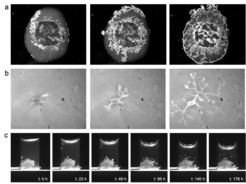Active Biological Matter
Adaptive motility of Physarum Polycephalum
Motility is the ability of a single cell or organism to move independently using metabolic energy. Among the various types of cell motility, amoeboid motility is a crawling-like movement observed primarily in amoeboid cells such as Dictyostelium Discoideum or Physarum Polycephalum. It is known that actomyosin mechanism in Dictyostelium Discoideum can swim in viscous media by performing chemotaxis. Although the motility of amoebae is surface-adherent locomotion, it is reasonable to assume that they have been exposed to very unusual physical and environmental conditions during the billions of years of their evolution and existence. The information to overcome these conditions could be embedded in their genetic information that would manifest when exposed to these unusual or extreme environmental conditions.
Physarum Polycephalum grows to a large surface area (up to meter scale) during the plasmodial phase of its life cycle and is known for very extensive adaptive cytoplasmic spreading. Adaptive cytoplasm streaming offers the possibility of being used as a model organism for research topics such as long distance cell motility, cellular differentiation and chemotaxis. Through experimental work, we have found that Physarum Polycephalum is able to overcome physical constraints and survive to escape these conditions, although this may take several days. We introduce physical constraints such as compression between two solid layers or confinement in a viscous gel-like medium. Since the preferred environment of it is wet open surfaces, it is common to have a network of tubes organising cytoplasmic streaming. Our observations show that the plasmodial Physarum polycephalum is capable of forming multiple off-springs, smaller units that can overcome physical constraints. In addition, we observed that it forms a polar structure on viscous media that enables motility on the viscous medium. Using the experimental results, we aim to develop an understanding of how cytoplasmic streaming alters accordingly to the challenging physical environments which leads to this unique adaptive motility.

Experimental observations of adaptive motility of Physarum Polycephalum under extreme environmental conditions. a) Adaptation of Physarum Polycephalum network entrapped in a viscous hydrogel on a glass substrate. b) Polar networking of Physarum Polycephalum on a viscous hydrogel and swimming dynamics. (c) Self-assembly of multiple offsprings of a Physarum Polycephalum and their upward swimming.
1- PNAS, 107 (25) 11376-11380, 2010. https://doi.org/10.1073/pnas.1006327107
2- PNAS, 114 (20) 5136-5141, 2017. https://doi.org/10.1073/pnas.1618114114
3- PNAS, 110 (33) 13306-13311, 2013. https://doi.org/10.1073/pnas.1305049110
